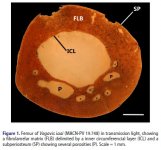Fred Ruhe
Well-known member

Jordi Alexis Garcia Marsà, Federico L. Agnolín & Fernando Novas, 2017
Bone microstructure of Vegavis iaai (Aves, Anseriformes) from the Upper Cretaceous of Vega Island, Antarctic Peninsula
Historical Biology, Latest Articles
Pages 1-5 | Received 09 Feb 2017, Accepted 26 Jun 2017, Published online: 11 Jul 2017
Abstract: http://www.tandfonline.com/doi/full/10.1080/08912963.2017.1348503
Vegavis iaai is a neornithine bird coming from the Late Cretaceous Sandwich Bluff Member of the López de Bertodano Formation (Maastrichtian), Antarctic Peninsula. Vegavis constitutes the only unquestionable Cretaceous neornithine bird, and is known by the holotype and specimen MACN-PV 19.748. The goal of this paper is to present a detailed osteohistological analysis of V. iaai. Vegavis shows a highly vascularized fibrolamellar matrix lacking lines of arrested growths, features widespread among modern birds. This is consistent with previous hypotheses indicating that modern birds were dominant at high latitudes. This is probably related to high-metabolic rates shared by modern birds, whereas archaic taxa as Enantiornithes are absent or form a minority part of High-Latitude bird assemblages. Vegavis was a diver, characterised by a certain degree of limb osteosclerosis, with an increase of bone inner compactness, and inhibition of secondary remodelling, with no effect on the external dimensions of the bone, a combination of characters related to diving lifestyle. Based on Relative Bone Thickness it is possible to infer that Vegavis was a foot-propelled diving bird, similar to some extant anseriforms. Occurrence of osteosclerotic limb bones in Vegavis and Polarornis may constitute a derived shared feature, sustaining the hypothesis that both taxa are phylogenetically related.
Enjoy,
Fred
Bone microstructure of Vegavis iaai (Aves, Anseriformes) from the Upper Cretaceous of Vega Island, Antarctic Peninsula
Historical Biology, Latest Articles
Pages 1-5 | Received 09 Feb 2017, Accepted 26 Jun 2017, Published online: 11 Jul 2017
Abstract: http://www.tandfonline.com/doi/full/10.1080/08912963.2017.1348503
Vegavis iaai is a neornithine bird coming from the Late Cretaceous Sandwich Bluff Member of the López de Bertodano Formation (Maastrichtian), Antarctic Peninsula. Vegavis constitutes the only unquestionable Cretaceous neornithine bird, and is known by the holotype and specimen MACN-PV 19.748. The goal of this paper is to present a detailed osteohistological analysis of V. iaai. Vegavis shows a highly vascularized fibrolamellar matrix lacking lines of arrested growths, features widespread among modern birds. This is consistent with previous hypotheses indicating that modern birds were dominant at high latitudes. This is probably related to high-metabolic rates shared by modern birds, whereas archaic taxa as Enantiornithes are absent or form a minority part of High-Latitude bird assemblages. Vegavis was a diver, characterised by a certain degree of limb osteosclerosis, with an increase of bone inner compactness, and inhibition of secondary remodelling, with no effect on the external dimensions of the bone, a combination of characters related to diving lifestyle. Based on Relative Bone Thickness it is possible to infer that Vegavis was a foot-propelled diving bird, similar to some extant anseriforms. Occurrence of osteosclerotic limb bones in Vegavis and Polarornis may constitute a derived shared feature, sustaining the hypothesis that both taxa are phylogenetically related.
Enjoy,
Fred




